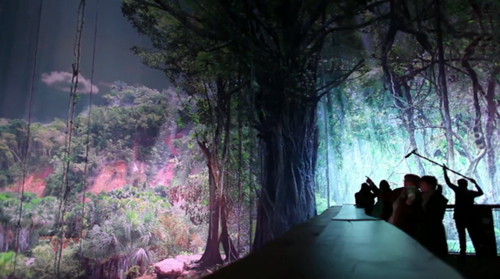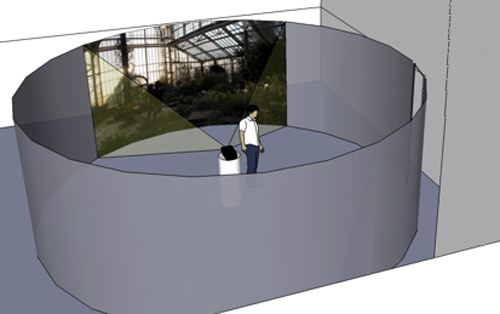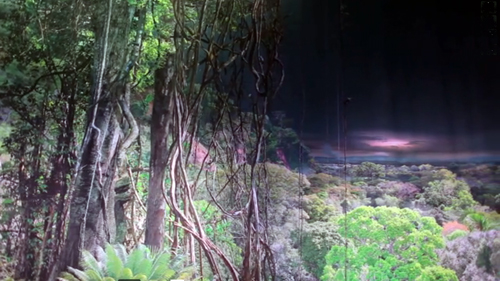A Landscape of Known Facts
2010

A Landscape of Known Facts transforms the gallery into a circular space with a projector in the middle, turning slowly on it’s own axis. The landscapes of the video are projected as from a lighthouse; a beam that scans the circular room in a slow, continuous, 360 degree revolution.

Influenced by the early development of cinematic special effects, A Landscape of Known Facts takes it’s point of departure in the history of the panoramic spectacle, while also layering the projected image with matte painting and textual elements applied to the screen. Scanning three different European panoramapaintings their architecture and their viewers, the camera is positioned off-centre, breaking the perfect circle that is constructed by the panorama to make it appear as if it was a world unto itself. Inside the panorama we hear fragments of conversations – people who travel, see, purchase tickets, behold spectacles, and consume images.
The video is one of landscapes - both the image of the landscape depicted as well as the landscapes of spectators and their spatial organisations; their bodies, gazes, knowledge and desires projected into the space of the image.
The beam of the projector slowly reveals drawings made directly on the circular wall; drawings upon which the projected images sometimes comment, and sometimes are commented upon. The shadows of people visiting the piece fall on the wall and blend with the filmed silhuettes of those present in the panoramas when recorded.

Some historical background on panorama-paintings:
For the first decades of the nineteenth century and during their renaissance at the end of the same century, panoramas were a popular choice of entertainment and spectacle. Often installed in purpose-built structures for extended periods of time, a visit to a panorama aroused sensations of likeness and deception, sensations that had perhaps never been experienced in such an overtly illusionist setting in the visual history of painting.
Designed to present a panoramic view of the world for both entertainment and education, their battle-scenes and romantically envisaged landscapes drew in the crowds and can be seen as the first (instance of) mass-medium.
The artist who first patented the idea of the 360 degree exhibition as ‘la nature à coup d’oeil’ or ‘nature at a glance’ was Edinburgh-based Irishman Robert Barker. His 1787 – same period as Jeremy Bentham’s Panoptikon – patent focused on the conditions of viewing, detailing the platform structure, lighting, barriers and other architectural features that could be positioned and constructed to restrict and open the field of vision with the maximum potential for suspending one’s disbelief.
The forms of viewing that had begun in the cyclorama constructions had later developed into moving panoramas, complete with stage-lighting and other dramatic effects.The panorama as spectacle was eclipsed by the moving image but it had also prepared spectators for the moving-screen experience. As prototype cinemas, the panorama asked the spectator to create movement by circling around the interior, believing in the illusion of the space and it’s image and surrendering oneself to the fantasy of the real.
By creating a view in all directions the panorama provided a sense of having an overview of the world, and empowered the spectator to know what power knows when looking at the world.
On the one hand side a “liberation” or democratization of the mass-viewer, this world view also placed the viewing subject as a consumer of images. The construction of an image becomes the construction of a space, and to conquer an image you must first consume it.
The space of video installation is related to the tradition of landscape painting and its placement and education of the spectator in a web of representation, power and desire.
A Landscape of Known Facts questions what it means to consume images. What it means to look when one is placed in the middle of a constructed world such as the panorama: a world of images and positions from where they are supposed to be seen. Which images are presented, appear valuable, what worlds do they teach us and from where can they be consumed?
---
A Landscape of Known Facts was commissioned by Project Arts Centre, Dublin. 2010.
Big thank you's to Tessa Giblin (curator), Angela Andersson (production), Catalina Fernandez (photography), Jack (technical genious), Brian Crosby (sound & voice), Layla O'Mara (voice), Simon Sheikh (input), Rike Frank (input).
|